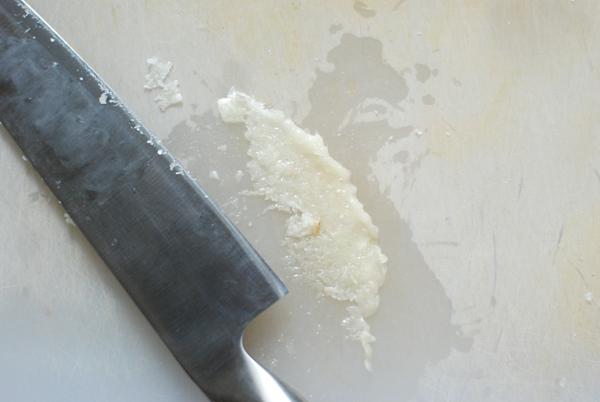I think you’ll be happy to know that I’ve found a legitimately easy way to tame the most finicky of vegetables into submission. I’m talking about eggplant, of course. Eggplant is beautifully purple (or white with purple speckles!) until you cut into it, when it’s suddenly grey-brown. It’s thick and sturdy, until you start frying it, when it seems to soak up exactly as much oil as is in the pan, always with room for more. Then it suddenly turns to mush, and from there, there’s no going back. Yeah, eggplant is finicky. I said it.
I’m over here breaking a sweat about my ‘plants, but Yotam Ottolenghi is unfazed. From the gorgeous eggplant gracing the cover of his second book, Plenty, you’d never know the vegetable was the cause of such stress. The globes are perfectly browned, drizzled with sauce, and dappled with red gems of pomegranate. They’re practically begging you to stop whatever it is that you’re doing (probably ruining eggplant), and make them. So I did, and I did.
Here’s what I’ve learned. Unless you’re slicing your eggplant thinly enough that a quick dip in oil will cook it right through, the trick is to soften it by either roasting, instead of running immediately for the fryer. This way, the eggplant softens without getting too greasy. You can always fry it at the end to get that extra crispness, but if you make prepare eggplant a la Plenty, I’m guessing you won’t want to. Ottolenghi has you score the eggplant flesh crosswise before drizzling it with olive oil and broiling it, exposing more surface area. As the eggplant bakes, the scored flesh crisps up on all sides, adding textural contrast to the surface while staying soft within. The yogurt sauce is redolent of garlic; it’s a perfect contrast to the juicy, tart pomegranate that finishes the dish.
Pomegranates aren’t exactly in season right now, but I finished the eggplant with a drizzle of pomegranate syrup, which worked very well. If you have saba, you definitely could use it. It’s sweeter than pomegranate syrup, but still plenty tart. I’m pretty sure Cathy tried this with saba and loved it.
I can see using this eggplant roasting technique for so many things. When I was in Mississippi for work earlier this week, I dug my way through a stack of eggplant parmesan that tasted more like breadcrumbs than eggplant. Can you imagine riffing on parm with this roasted eggplant half? It’d be amazing. I’d maybe tuck some pesto into the olive oil before drizzling it on for the roast, and when the eggplant comes out of the oven sizzling, I’d top it with hot tomato sauce, maybe even some fresh mozzarella cheese before popping it back under the broiler for a hot minute. Mouth=watering.
Roasted Eggplant with Yogurt and Pomegranate
Adapted from Plenty, by Yotam OttolenghiOttolenghi recommends you cook these eggplants for 35-40 minutes, but mine needed more like 60-75 before they were truly tender. Check early, but be prepared for a longer cooking time.
For the eggplant:
2 large and long eggplants
1/3 cup olive oil
1 1/2 teaspoons fresh thyme or lemon thyme, plus a few whole sprigs to garnish
Sea salt and black pepper
Seeds of 1 pomegranate or 2 tablespoons pomegranate syrup
2 teaspoons za’atarFor the sauce:
1/4 cup buttermilk (or substitute regular milk with a squeeze of lemon)
1/2 cup Greek yogurt
1 1/2 tablespoons olive oil, plus a drizzle to finish
1 small garlic clove
1 pinch flaky saltPreheat the oven to 350°F. Cut the eggplants in half lengthways, cutting straight through the stalk. Use a small sharp knife to score three or four parallel cuts into the eggplant flesh, without cutting through to the skin. Repeat at a 45-degree angle to get a diamond-shaped pattern.
Place the eggplant halves, cut-side up, on a baking sheet lined with parchment paper. Drizzle or brush them with olive oil, brushing until all of the oil has been absorbed. Sprinkle with the thyme and some salt and pepper. Roast for 60-75 minutes, at which point the flesh should be soft, flavorful, and nicely browned. Remove from the oven and let cool.
To make the sauce: mash the garlic and the pinch of salt on a cutting board with a chef’s knife until garlic is completely smooth. (Alternatively, simply send the garlic through a press.) Then whisk together all of the ingredients, taste for seasoning, and store in the refrigerator until needed.
To serve, spoon plenty of buttermilk sauce over the eggplant halves without covering the stalks. Sprinkle za’atar and plenty of pomegranate seeds (or pomegranate syrup) on top and garnish with thyme. Finish with a drizzle of olive oil.





Comments on this entry are closed.
I was once served a roasted eggplant dressed in tahina by a Moroccan friend. Roasted eggplant parm? Sounds divine!
YES! Roasting is the way to go, I agree. This recipe looks like a perfect choice to bring to friends this Labor Day weekend. Running to my farmers’ market NOW to pick up a load of ’em!
I stare at the cover of plenty every time I come across it in stores. The roasted eggplant look beautiful with the thick white yogurt and red pomegranate. You did a great job recreating it.
I’m Moroccan so I make so many eggplant variations. I also have a roasted eggplant salad on my blog that uses green onions and cilantro. There are countless ways of dressing an eggplant.
This eggplant looks amazing! And I don’t even care if pomegranates aren’t in season – I’ll find a way to make this =)